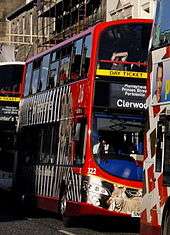Edinburgh Waverley railway station
| Edinburgh Waverley | |
|---|---|
|
View of Edinburgh Waverley from the east | |
| Location | |
| Place | Edinburgh |
| Local authority | City of Edinburgh |
| Coordinates | 55°57′08″N 3°11′21″W / 55.9521°N 3.1893°WCoordinates: 55°57′08″N 3°11′21″W / 55.9521°N 3.1893°W |
| Grid reference | NT257738 |
| Operations | |
| Station code | EDB |
| Managed by | Network Rail |
| Number of platforms | 18 |
|
Live arrivals/departures, station information and onward connections from National Rail Enquiries | |
| Annual rail passenger usage* | |
| 2011/12 |
|
| – Interchange |
|
| 2012/13 |
|
| – Interchange |
|
| 2013/14 |
|
| – Interchange |
|
| 2014/15 |
|
| – Interchange |
|
| 2015/16 |
|
| – Interchange |
|
| History | |
| Original company | Edinburgh, Leith and Newhaven Railway, Edinburgh and Glasgow Railway and North British Railway |
| Pre-grouping | North British Railway |
| Post-grouping | LNER |
| 22 June 1846 | North Bridge built by NBR[1] |
| 17 May 1847 | General Station built by E&GR[1] |
| 17 May 1847 | Canal Street built by EL&NR[1] |
| April 1866 | NBR demolished existing stations; replaced with Edinburgh Waverley[1] |
| 18 April 1966 | Renamed Edinburgh[1] |
| ? | Renamed Edinburgh Waverley |
| National Rail – UK railway stations | |
| * Annual estimated passenger usage based on sales of tickets in stated financial year(s) which end or originate at Edinburgh Waverley from Office of Rail and Road statistics. Methodology may vary year on year. | |
|
| |
Edinburgh Waverley railway station (also known simply as Edinburgh or as Waverley) is the principal station serving Edinburgh, the capital city of Scotland.[2][3] It is the northern terminus of the East Coast Main Line, 393 miles 13 chains (632.7 km) from London King's Cross, although some trains operated by Virgin Trains East Coast continue to other Scottish destinations beyond Edinburgh.[4]
As well as the Virgin Trains terminating and through services, there are many local services operated by ScotRail, including four routes to Glasgow, the Fife Circle, and services to Stirling/Dunblane/Alloa/North Berwick/Dunbar, and the station is the terminus of the Edinburgh leg of the West Coast Main Line served by Virgin Trains and TransPennine Express. Long distance inter-city trains to England are operated by CrossCountry to destinations such as York, Leeds, Sheffield, Derby, Birmingham New Street, Bristol Temple Meads, Exeter St Davids and Plymouth.
Location

Waverley station is situated in a steep, narrow valley between the medieval Old Town and the 18th century New Town.
Princes Street, the premier shopping street, runs close to its north side. The valley is bridged by the North Bridge, rebuilt in 1897 as a three-span iron and steel bridge, on huge sandstone piers. This passes high above the station's central section, directly over the central booking hall (which cleverly hides one of the main stone piers within its bulk). Waverley Bridge lies to the west side of the station (though platforms extend below it) and it is this road which, by means of ramps, formerly afforded vehicular access to the station and still provides two of the six pedestrian entrances to the station. The valley to the west, formerly the site of the Nor Loch, is the public parkland of Princes Street Gardens.
History

Edinburgh's Old Town, perched on a steep-sided sloping ridge, was bounded on the north by a valley in which the Nor Loch had been formed. In the 1750s overcrowding led to proposals to link across this valley to allow development to the north. The "noxious lake" was to be narrowed into "a canal of running water", with a bridge formed across the east end of the loch adjacent to the physic garden. This link was built from 1766 as the North Bridge and at the same time plans for the New Town began development to the north, with Princes Street to get unobstructed views south over sloping gardens and the proposed canal. The loch was drained as work on the bridge proceeded. In 1770 a coachbuilder began work on properties feued at the corner between the bridge and Princes Street, and feuers on the other side of the street strongly objected to this construction blocking their views to the south. A series of court cases ended with the decision that the buildings nearing completion could stay, immediately to the west of that some workshops would be allowed below the level of Princes Street, and further west a park would be "kept and preserved in perpetuity as pleasure ground" in what became Princes Street Gardens.[5]
In the mid 1830s proposals for a railway from Glasgow running along the gardens to a station at the North Bridge were set out in a prospectus with assurances that the trains would be concealed from view, and smoke from them "would scarcely be seen". An association of "Princes Street Proprietors" who had feued houses in the street, and had spent large sums turning the "filthy and offensive bog" of the Nor Loch into quiet gardens, strongly opposed the railway and in late 1836 put forward their case against the Act of Parliament for the railway. The Edinburgh and Glasgow Railway opened in 1842 with its terminus at Haymarket railway station, stopping short of Princes Street. In the Railway Mania of the 1840s, the railway sought another Act of Parliament allowing access along the gardens, and at the same time two other railways proposed terminus stations at the North Bridge site. By then several of the Princes Street properties were shops or hotels with an interest in development, and agreement was reached in 1844 on walls and embankments to conceal the Edinburgh and Glasgow railway line in a cutting, with compensation of almost £2,000 for the proprietors.[6]
The North Bridge station was opened on 22 June 1846 by the North British Railway as the terminus for its line from Berwick-upon-Tweed. The Edinburgh and Glasgow Railway's General station opened on 17 May 1847, on the same day as the Canal Street station of the Edinburgh, Leith and Newhaven Railway, serving Leith and Granton via a long rope-hauled tunnel under the New Town. The collective name "Waverley", after the Waverley Novels by Sir Walter Scott, was used for the three from around 1854 when the through 'Waverley' route to Carlisle opened. Canal Street station was also known as Edinburgh Princes Street,[1] not to be confused with the Caledonian Railway railway station later built at the West End which was named Princes Street station from 1870.
In 1868 the North British Railway acquired the stations of its rivals, demolished all three, and closed the Scotland Street tunnel to Canal Street. The present Victorian station was built on the site, and extended in the late 19th century. Waverley has been in continual use since, under the auspices of the North British, the LNER, British Railways (rebranded as British Rail after 1965), Railtrack and latterly Network Rail. From its opening in its current form by the eastward tunnelled extension from Haymarket, Waverley has been the principal railway station in Edinburgh. From 1870 to 1965 the city had a second major station, Princes Street, operated by the rival Caledonian Railway, but this was never as important as Waverley.

As at other large railway stations of the Victorian and Edwardian eras, the railway company constructed a grand station hotel beside their station. The North British Hotel, adjacent to the station at the corner between Princes Street and North Bridge (on the site of the coachworks[5]) opened in 1902. In 1983 British Rail sold it to the Forte hotel group. In 1988 Forte closed the hotel for a year to extensively remodel and update what had become something of a faded jewel. When it reopened it was rechristened The New Balmoral Hotel, maintaining the "NB" initials in what has proved to be an astute marketing move, despite the hotel being 115 miles (185 km) from Balmoral Castle. Subsequently, "New" was dropped from the name. The hotel enjoys commanding views over central Edinburgh and is one of the most luxurious (and expensive) hotels in the UK. There is no longer a direct entrance from the station.
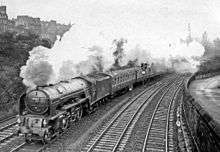
British Rail brought railway electrification in 1991 with electric trains on the East Coast Main Line to Glasgow Central and via York to London King's Cross.
The station's large size and the unusual topography of its surroundings mean that it contains a large amount of valuable centrally located land. The station's successive owners, British Rail, Railtrack and its current owner Network Rail have been criticised for underusing the valuable city-centre spaces available within, there being a legal covenant preventing any upwards extension, which would obstruct the view of Arthur's Seat from Princes Street. The elevated walkway linking the Waverley Steps (from Princes Street to Market Street) has been upgraded with the recommissioning of the suburban platforms (at the south) and provision of additional through platforms to the north to serve the increased proportion of through rail traffic.
Princes Mall (formerly the Waverley Shopping Centre), which occupies a column of space (formerly Waverley Market, a live cattle market) nestling between Waverley Station, Waverley Bridge, and Princes Street, opened in 1985. This mall has benefited from the installation of escalators on the Waverley Steps to Princes Street in 2011.
Recent developments

During 2006 and 2007 parts of Waverley were extensively refurbished, including two new through platforms and the electrification of Platforms 12 to 18 in preparation for electric trains from the Airdrie-Bathgate Rail Link and future lines in Scotland to be electrified by the current (2012) EGIP (Edinburgh/Glasgow Improvement Project).[7]
From 2010 to 2012, the glazing of the roof of Waverley station was entirely replaced with new strengthened clear glass panels, replacing the old 34,000 m2 of mixed surfaces including felt, cloudy wired glass and plastic sheet. Part of a £130 million upgrade, this has greatly increased the amount of natural light in the station.[8][9][10]
From 2012 to 2014 improvements included: a new set of covered escalators leading to Princes Street (replacing the huge set of previously wind-swept steps); a rebuilt and widened entrance from Market Street; a rebuilding of the canopies on the southern "suburban line"; a restoration of the central space in the ticket hall; and major improvements to the Calton Road access. Internally several new lifts and escalators have greatly aided circulation.[11]
A new drop-off point and disabled parking/access was added on the Calton Road access in 2014.
Services


Trains leave Waverley in two directions:
- Eastbound: following a series of closures culminating in that of the Waverley Route in 1969, the only services departing from the east end of Waverley were East Coast Main Line expresses (primarily to London King's Cross and Birmingham New Street), and local trains to North Berwick and Dunbar. Recently, the Edinburgh Crossrail scheme has seen a short stub of the Waverley Route reopened to Newcraighall, followed more recently by the partial reopening of the Waverley Route proper,which now sees trains running to Tweedbank in the Scottish Borders.
- Westbound: the line passes through Princes Street Gardens to Haymarket station. From here, the line to Carstairs and the West Coast Main Line to Carlisle and the South as well as the Edinburgh-Glasgow via Shotts line to Glasgow Central diverges to the south. The next line to diverge is the line for the Forth Bridge and Fife to the north, with services to Glenrothes, Dundee, Perth, Aberdeen and Inverness. The Edinburgh-Glasgow via Bathgate line diverges to the south at Newbridge Junction, carrying services for Milngavie and Helensburgh Central via Glasgow Queen Street low level. Finally, at Polmont Junction, the main Edinburgh-Glasgow line splits from the Stirling and Dunblane line. The former is served almost exclusively by Abellio ScotRail's main Glasgow service (via Falkirk High) and the latter by services for Dunblane, Alloa and Perth.
- Virgin Trains East Coast operates a half-hourly service to London King's Cross, one fast and one semi-fast, throughout the day with all trains calling at Newcastle Central and most at York. Services to London on average take four hours and twenty minutes (fast), or four hours and forty-five minutes (semi-fast). The exception to this is the 05:40 Flying Scotsman service which only calls at Newcastle and completes the journey to London in four hours. In the other direction, through services extend to Aberdeen (4 each way per day), Inverness (1 per day) and Glasgow (1 per day). Since December 2015 there is also a daily service to Stirling in each direction. Other long-distance to Glasgow Central are operated by CrossCountry (every two hours).
- CrossCountry operate an hourly service to Plymouth via Newcastle, Leeds, Sheffield, Derby, Birmingham, Bristol and Exeter. Some services extend to Penzance and on summer weekends, Paignton and Newquay. Northbound a couple of services extend to Dundee or Aberdeen. Westbound this is extended to Glasgow Central every two hours. There is also one train per day to Reading.
Winter 2007
On 11 December 2007, First TransPennine Express commenced services between Edinburgh Waverley and Manchester Airport via Manchester Piccadilly, Preston and the West Coast Main Line replacing Virgin CrossCountry services.
Winter 2008
On 14 December 2008, Virgin Trains withdrew its daily Edinburgh Waverley to London Euston service and First ScotRail Newcraighall trains ceased to continue onto the Bathgate Line and were extended to the Fife Circle Line instead, in anticipation of the electrification of the Bathgate services (Airdrie-Bathgate Project, completed 2010) and implementation of the Borders rail project to Tweedbank which commenced services there in September 2015.
Winter 2013
From 8 December 2013, Virgin Trains introduced regular links to London Euston with the combination of the existing two-hourly WCML service to Birmingham New Street via Preston with the Wolverhampton to Euston service.
Routes – past and present
Future
In May 2016 ORR gave the green light to a new operator called East Coast Trains which would operate services to Edinburgh Waverley via Stevenage, Newcastle & Morpeth. The service would begin operation in 2021.[12][13][14]
Layout
A total of 24 platforms have existed at Waverley, but not more than 21 at any one time. Prior to incremental rationalisation of the east end in the 1960s–80s there were 21 platforms. The main station was effectively a large 'island' with through lines on the outside, and terminating platforms at both ends in between. In December 2006, a partial renumbering of platforms took place to reflect the construction of three new platforms.
At the north side of the station is the former Up Main through platforms, a very long platform with the tracks having a crossover to a parallel line in the centre, numbered 19 (west end) and 2 (formerly 1) (east end).
The east end terminating platforms have undergone significant rationalisation. From north to south these comprised:
- former Platforms 2 and 3, which were latterly used for parcels/mail traffic only and were removed in the 1980s when a new Royal Mail facility was built on their site;
- former Platforms 4 and 5 were also retained for parcels/mail traffic until this ceased; Platform 5 was reopened to passengers in 2006 as the new Platform 3;
- former platforms 6 and 7, of which only the latter survives, now numbered 4; and
- former Platforms 8 and 9, which were substantially shortened for use as a Motorail terminus, the infilled area becoming a car park; since the demise of Motorail services these platforms are used only for locomotive stabling, although the numbers 5/6 were reserved for them in the 2006 renumbering. These are to be extended as full length platforms to accommodate terminating CrossCountry and Virgin Trains East Coast services with the taxi rank closed in June 2014 to make way for these works.[15][16]
The former Down Main through Platforms 7 (east end) and 8 (west end) are at the south side of the main station, and comprise a single very long platform with a crossover in the centre. They are numbered 7 (formerly 10, east end) and 11 (west end).
At the west end there has been little change to the terminating platforms, apart from widening them by removing disused centre-road tracks. The platforms comprise (south-north) numbers 12/13, 14/15, 16/17 and bay Platform 18. These were not affected by the 2006 platform renumbering scheme.
The only platforms outwith Waverley's overall roof are the former 'Suburban' Platforms 8 and 9 (formerly 21 and 20), a lengthy island platform. These are on the southern edge of the station, adjacent to the east to the former freight depot (now a car park and offices) and with direct access to Market Street, which runs parallel to the railway to the immediate south.
A need to increase capacity for through and west-end traffic led to three new platforms being built in 2006, on land formerly occupied by disused sidings and bypass lines within the main part of the station. Platform 10 is a through platform at the west end, facing Platform 11. Platforms 1 and 20 are a single long through platform facing Platforms 2 and 19. All are linked by the upgraded north-south overhead walkway linking the Waverley Steps (escalators) to Market Street.

Gallery
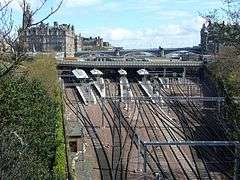 Waverley station viewed from East Princes Street Gardens
Waverley station viewed from East Princes Street Gardens Waverley station viewed from Edinburgh Castle
Waverley station viewed from Edinburgh Castle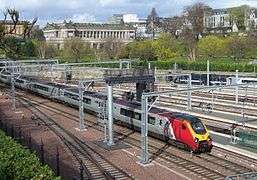 An eastbound train enters Waverley station
An eastbound train enters Waverley station Westbound trains waiting at Waverley
Westbound trains waiting at Waverley- ScotRail and Virgin Trains services at the western end of the station
- Westward view across the roadway between Platforms 7 and 11 (left) and the main concourse, with the Mezzanine Bridge visible above
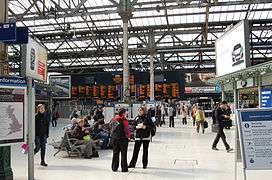 Waverley station concourse
Waverley station concourse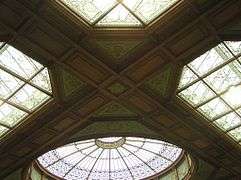 The elaborate ceiling of the ticket hall, extensively restored in 2003
The elaborate ceiling of the ticket hall, extensively restored in 2003 ScotRail train after arriving from Glasgow Queen Street station
ScotRail train after arriving from Glasgow Queen Street station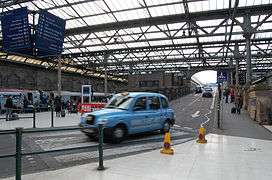 Taxi entering the station. On 2 June 2014 taxis were banned from entering the station concourse and now have to use taxi ranks outside the station.
Taxi entering the station. On 2 June 2014 taxis were banned from entering the station concourse and now have to use taxi ranks outside the station.
References
- 1 2 3 4 5 6 Butt (1995), page 89
- ↑ Network Rail: Our Stations – Edinburgh Waverley 27 August 2013
- ↑ Edinburgh | Scotrail 14 June 2015
- ↑ "Commercial information" (PDF). Complete National Rail Timetable. London: Network Rail. May 2013. p. 43. Retrieved 5 June 2013.
- 1 2 Youngson, A.J. (1966), The Making of Classical Edinburgh, Edinburgh University Press, pp. 12–14, 86–90
- ↑ Youngson, A.J. (1966), The Making of Classical Edinburgh, Edinburgh University Press, pp. 275–278
- ↑ "Edinburgh Waverley Train Station". EdinburghGuide.com. Retrieved 21 August 2013.
- ↑ edg (13 January 2010). "New Roof For Waverley Station Moves Step Closer". EdinburghGuide.com. Retrieved 21 August 2013.
- ↑ "Edinburgh Waverley". Network Rail. Retrieved 21 August 2013.
- ↑ Dalton, Alastair (15 April 2009). "Stronger Waverley roof will save public from bridge jumpers". The Scotsman. Edinburgh.
- ↑ edg (28 September 2009). "Work Starts on £130m Refurbishment for Edinburgh Waverley". EdinburghGuide.com. Retrieved 21 August 2013.
- ↑ Applications for the East Coast Main Line Office of Rail and Road 12 May 2016
- ↑ First Group to run Edinburgh to London budget rail service BBC News 12 May 2016
- ↑ VTEC and FirstGroup granted East Coast Main Line paths Railway Gazette International 12 May 2016
- ↑ "Taxi ban starts at Edinburgh". Rail News, June 2014, p.8.
- ↑ Edinburgh Waverley Station: Two new platforms to replace taxi ranks BBC News 22 August 2014
Sources
- Butt, R. V. J. (1995). The Directory of Railway Stations: details every public and private passenger station, halt, platform and stopping place, past and present (1st ed.). Sparkford: Patrick Stephens Ltd. ISBN 978-1-85260-508-7. OCLC 60251199.
- Jowett, Alan (March 1989). Jowett's Railway Atlas of Great Britain and Ireland: From Pre-Grouping to the Present Day (1st ed.). Sparkford: Patrick Stephens Ltd. ISBN 978-1-85260-086-0. OCLC 22311137.
- Jowett, Alan (2000). Jowett's Nationalised Railway Atlas (1st ed.). Penryn, Cornwall: Atlantic Transport Publishers. ISBN 978-0-906899-99-1. OCLC 228266687.
Further reading
| Wikimedia Commons has media related to Edinburgh Waverley railway station. |
- Glen, Ann (2013). Edinburgh Waverley. Lily Publications Ltd. (UK). ISBN 9781907945250. OCLC 858090434.
- Meighan, Michael (2014). Edinburgh Waverley Station Through Time. Amberley Publishing. ISBN 9781445622163. OCLC 883514283.

